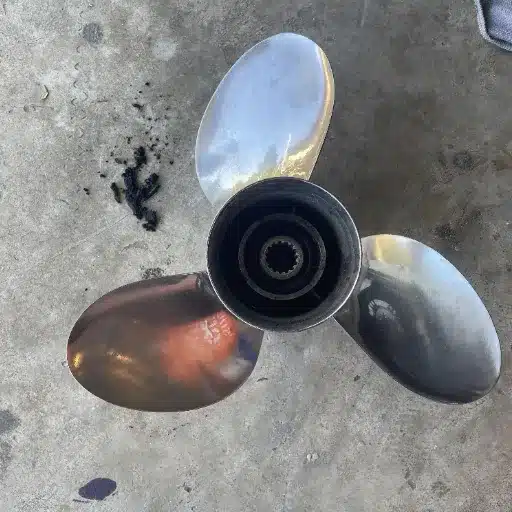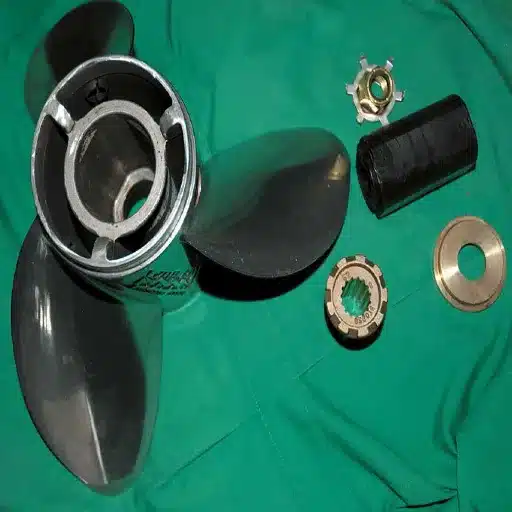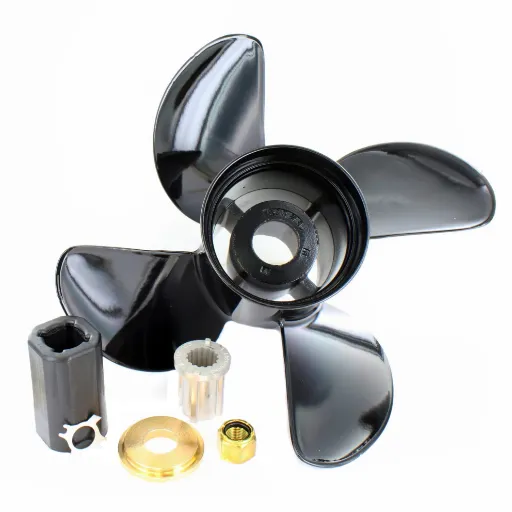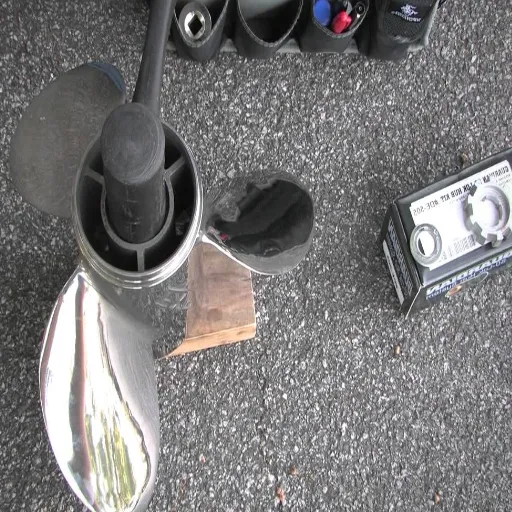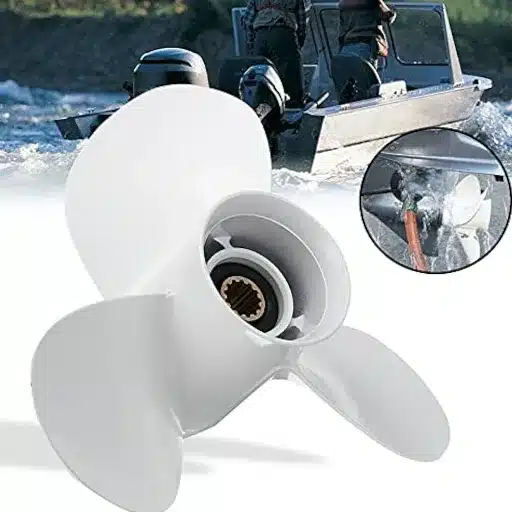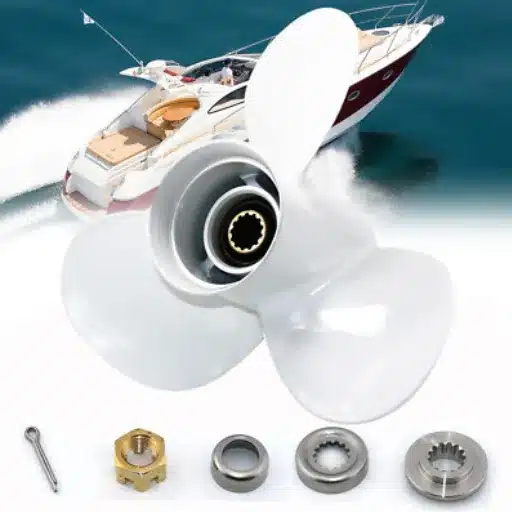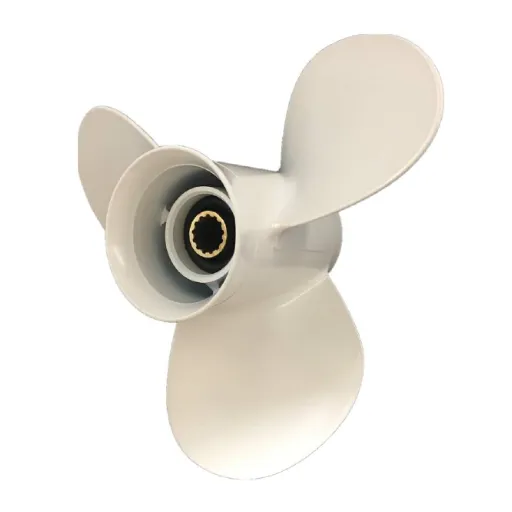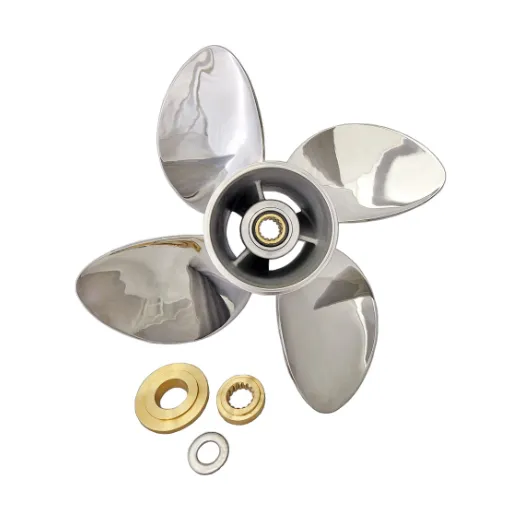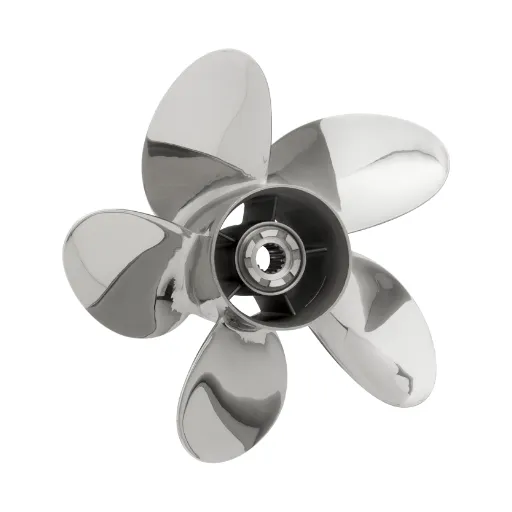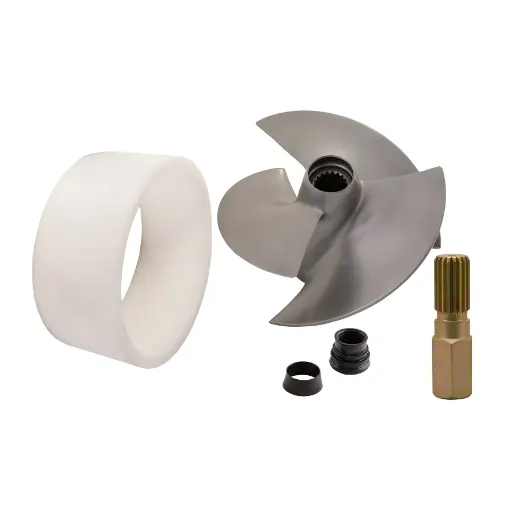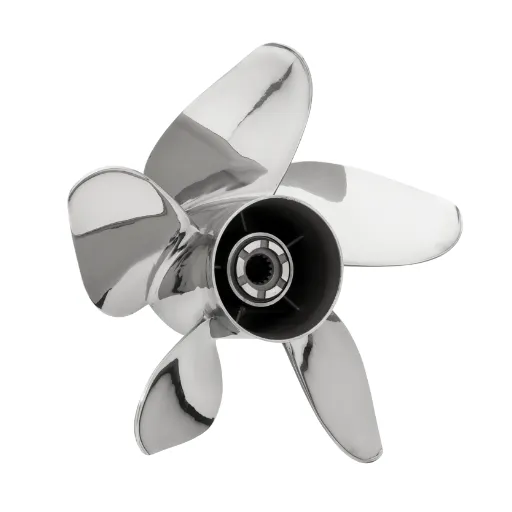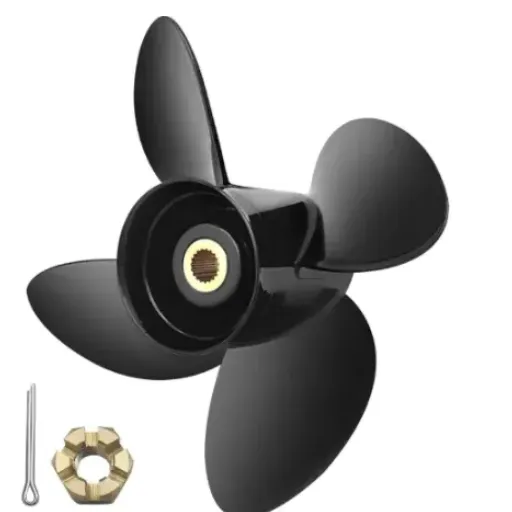Performance is generally optimized, qualities are enhanced for strength, and materials are ensured for long-term use. Among the diverse parameters that define a boat’s performance, the propeller is an important one. Even the best propellers can, in one way or another, encounter a “spun prop.” This technical crime is relatively common and is often misunderstood. In this article, we will dive deep into the dynamics of a spun prop–how it works, the defining characteristics of the condition, and how it impacts boating efficiency. This guide will arm you with the knowledge to identify, solve, or even prevent problems caused by spun propellers, ensuring a smooth sailing on your next trip, be it for an experienced sailor or an interested student of the trade.
Understanding the Basics of Spun Props
What Is a Spun Prop?
A spun propeller occurs when the rubber hub inside the boat propeller separates from or slips out of its central housing, thus creating an ineffective link between the propulsion power being transmitted from the engine to the propeller. The result is a significant loss of thrust, despite the engine running, as the propeller is unable to function correctly in propelling the boat. The hub is commonly made of rubber to absorb vibrations and protect the drivetrain from sudden shocks. On the other hand, excessive wear and tear, aging, or sudden shocks-the kind one gets from hitting an underwater obstruction-can cause the bonding between the hub and the propeller to give way.
Operational signs of the spun prop may often include noticeable speed deterioration or a performance drop, despite the engine running normally at rated revolutions per minute (RPM). For example, the boat may struggle to plane or reach the expected speeds. Such an issue needs to be addressed with all haste, as it diminishes propulsion efficiency and may more severely strain the entire power unit if left unattended. Proper inspection, prophylactic maintenance of the propeller assembly, and testing of the rubber hub can help ensure that such conditions are avoided or provide timely warnings of failure should a damaged propeller be detected.
Chapter Easily Recognized Features of a Spun Prop Hub
These are several key indications signaling the failure of a spun prop hub, thereby warranting imperative repair attention. The primary symptom is severe attrition in propulsion efficiency, often accompanied by an increase in the engine’s revolutions per minute without a corresponding increase in vessel speed. Such a manifestation arises in the case of an impairment in a rubber hub within the propeller assembly, which loses the ability to transmit torque from the engine directly to the propeller blades.
The second key indication of a spun-out condition is the presence of normal wear or visible damage on the propeller hub. Such damages can reveal rubber degradation, cracking, or detachment from the metal hub shell. The presence of heat, friction, and mechanical stress over time will see the wear grow and predispose the hub to spinning.
One aspect includes diagnosing rotational slippage between the central spline and the outer propeller housing. This discrepancy is typically determined through visual analysis of the fit between the spline and hub, or by marking the hub and verifying alignment after operation. Some experts will even use torque-testing tools to confirm whether the hub meets predetermined torque standards.
The sooner these features are detected, the better it is for mechanical intervention, which otherwise might exacerbate the problems and thus necessitate the outright transformation of the propulsion system to its peak level.
Maintaining proper propeller hub conditions is thus directly related to the efficiency of fuel consumption, speed optimization, and the lifespan of the entire engine drive system.
⚠️ Key Warning Signs of a Spun Prop:
- Increased RPM without corresponding speed increase
- Visible rubber degradation, cracking, or detachment
- Rotational slippage between spline and housing
- Loss of propulsion efficiency
- Unusual vibrations during operation
Let’s discuss the role of the propeller in boating.
The propeller is a severe protagonist working directly to convert power into thrust via the propulsion system of the watercraft. This thrust essentially moves the vessel through the water with efficiencies and dynamics depending on the design, material, and geometry of the propeller. An oversized or undersized pitch can overwork or underutilize the ship’s engine, respectively, unnecessarily increasing fuel consumption or placing undue wear and tear on the machinery.
Improvements in propeller technology have now allowed manufacturers and propeller designers to tailor designs to particular types of vessels and uses. Under these circumstances, for example, variable-pitch propellers can significantly improve handling and alter performance characteristics depending on speed and load conditions. Stainless steel is also a current material of choice, in addition to its durability and corrosion resistance when working in a saltwater environment.
The analysis of data shows that even minor irregularities, such as damage to blades or an imbalance condition, can result in a considerable loss of efficiency. Research indicates that operators should perform regular maintenance to detect thrust efficiency issues that can exceed 10%. These research findings, therefore, demonstrate that precision engineering and care must always be exercised to maximize the longevity and performance of propulsion systems.
Causes and Effects of a Spun Prop
Common Causes of a Spun Prop
A spun propeller occurs when the rubber hub inside the propeller shears out or loses its grip on the propeller’s outer casing due to excessive stress or age-related wear. A frequent cause is being suddenly impacted by a submerged object, such as a rock or debris, generating torque much greater than the hub is designed for. Overheating will also degrade the rubber material, often caused by continuous operation at high speed, thereby reducing its ability to hold firmly under load. A poorly installed hub, or one subject to repeated corrosive conditions such as saltwater without proper cleaning or anodic protection, loses integrity even faster. Together, these working conditions impair the propulsion system’s ability to transmit power, resulting in slippage and further loss of performance.
Symptoms to Look For in Identifying a Spun Hub
A spun hub assumes several symptoms and consequences, each with a direct effect on the efficiency and safety of the propulsion system. One of the most common signs is a sudden loss of thrust when the engine theoretically operates within the same RPM range. This happens because the hub, unable to grip the propeller shaft completely, allows some amount of slippage to occur, and thus, the force is not transferred entirely onto the propeller blades.
Another tell-tale sign would be one or both engines suddenly revving excessively without any gain in the vessel’s speed, known as “over-revving.” This symptom indicates a disruption in the connection between the engine and the propeller. Also, vibrations or unusual noises, such as grinding, may be felt during operation, implicating a physical form of wear or damage within the hub assembly.
If inspected with attention, one can often observe wear patterns or even traces of rubber debris near the hub area, indicating that rotation has caused at least partial destruction of the components. Otherwise, expected degradation over time may suggest a progressive hub failure, particularly under strenuous conditions such as towing or navigating through currents. Early detection of these symptoms and immediate rectification prevents further damage to the system and restores performance.
Impact on Boat Performance
The condition of the hub affects the entire boat’s operation. If the hub is compromised in any way, it lowers power transfer from the engine to the propeller, with protection against loss of speed, increased fuel consumption, and poor handling. If the hub is completely compromised, then loss of propelling power will render the boat useless. The existence of vibrations caused by damage and wear to the hub will contribute negatively to the structural deterioration with age, which would also affect other vital components such as the drive shaft, engine mounts, and bearings.
Empirical evidence presents a show of how even slight slippage of the hub induces a precipitous drop in propulsion efficiency loss, varying up to 20-30% depending on the extent of damage and size of the vessel. Regular inspection and replacement of the propeller hub when necessary will maintain operational reliability, reduce fuel costs, and provide a pleasant boating experience for all.
Impact of Hub Condition on Boat Performance
| Condition | Performance Impact | Efficiency Loss | Recommended Action |
|---|---|---|---|
| Good Condition | Optimal | 0% | Regular maintenance |
| Minor Slippage | Reduced | 10-15% | Inspection & monitoring |
| Moderate Damage | Significantly Impaired | 20-30% | Immediate repair/replacement |
| Complete Failure | No Propulsion | 100% | Emergency replacement required |
Repairing and Maintaining Spun Props
How to Fix a Spun Prop
A spun propeller will require inspections, diagnosis, and repair of the propeller hub or possible replacement thereof to reinstate full functionality. Step-by-step process:
1
Remove the Propeller
Begin by loosening the propeller nut with a socket wrench. Move the propeller off the shaft with care to avoid damaging nearby components. Inspect the propeller and hub assembly for any visible signs of damage, including rubber debris and misalignment.
2
Inspect the Hub
Ideally, a hub is to act as a fail-safe when subjected to undue stress or impact, but as time passes, wear and failure will eventually set in. A spun hub is almost always prominent when the inner rubber sleeve has become detached from the outer casing. Excessive play or slippage between the hub and the propeller during rotation are signs to look for.
3
Designate Repair Requirements
A complete replacement of the hub is required when severe wear or separation occurs; minor wear or slipping can be corrected by simply pressing the hub with an expert. Remember that repeated pressing would reduce the long-term reliability of the hub and is not a permanent fixing for vessels in very active use.
4
Joint Replacement
If a proper replacement is required, purchase a suitable replacement hub kit specifically designed for your propeller and engine model, and use a hydraulic press at a shop equipped with the necessary machinery to install the hub tightly onto the shaft.
5
The Final Step
After repairing or replacing the hub, the propeller is ready to be reinstalled onto the shaft. Install the nut to the recommended torque specification before fitting the cotter pin, if any. Check the fit and rotate the propeller to ensure it spins freely.
6
Water Test
After reassembly, test the propeller on water using regular operating conditions. Monitor propulsion efficiency, vibrations, and RPM behavior to verify the repair.
Regular maintenance and periodic visual inspection of the propeller hub can help prevent problems with spun props. It is best to adhere to manufacturers’ maintenance interval recommendations and keep spare replacement parts available for emergencies.
Importance of Regular Maintenance
Performing maintenance is a crucial consideration for sustaining the desired performance level, extending the working life of a system, and reducing the likelihood of unexpected breakdowns. Upkeep measures, when taken in the propeller, engine, or drive system, would ensure the subjects operate within the desired limits of tolerance, thus minimizing wear and maintaining high efficiency. Neglecting such care can lead to examples such as cavitation, which causes reduced propulsion efficiency and increased fuel consumption over time.
Preventive maintenance can reduce downtime by up to 30%. The greater the respect for the schedule, the more economical. In addition to this, routine inspections confirm whether early signs of problems, such as corrosion, imbalance, or mechanical-type fatigue, are present, allowing one to solve such issues before they escalate. Upon incorporating more sophisticated diagnostics, including vibration or thermal imagers, condition monitoring and maintenance planning become more precise. In addition to routine maintenance, operators consider intermittent inspections that ultimately result in enhanced safety and performance levels.
✓ Benefits of Regular Maintenance:
- Reduces downtime by up to 30%
- Prevents efficiency loss exceeding 10%
- Extends propulsion system lifespan
- Reduces fuel consumption
- Early detection of corrosion and wear
Using of a Spare Prop and Hub Kit
Having an extra propeller and hub kit on board is an indispensable safety measure to ensure operational continuity in the event of unforeseen predicaments or emergencies. Usually, a spare prop and hub kit affords an immediate replacement in situations where damage has been inflicted upon the principal propeller as a result of underwater debris, collisions with submerged or floating objects, or simply long usage and associated wear and tear. This serves as a proactive measure, substantially reducing downtime and facilitating the swift reinstatement of propulsion performance in places where limited funding or indirect travel times hinder repair visits.
The choice of a spare propeller and hub kit involves several key factors, such as the material of evaluation — aluminum is an economical option and stainless steel offers premium strength — and compatibility with the outboard engine in place. Proper pitch and diameter specifications for spare propellers, when set precisely against the original ones, ensure that performance and fuel efficiency are restored perfectly. A new hub kit also tends to use cushioned inserts meant to provide a cushioning effect against sudden transmission shocks in the event of an impact.
Additionally, regular assessment of the spare components must be undertaken to ensure their readiness for operation. Keeping all the required tools onboard and having a step-wise procedure for replacement can expedite operations and minimize downtime during emergencies. Preventive preparation and regular maintenance provide a comprehensive package that enables operators to ensure operational resiliency and the vessel’s reliability under varying environmental conditions.
Trends in Propeller Technology for 2025
The Innovations in Propeller Hub Design
The designs in propeller hubs are continually innovated, with marine engineering as their backdrop, for engineered improvements in efficiency, durability, and sustainability. Modern designs emphasize an interface of advanced materials, from composite blends to high-strength alloys, which enhance performance attributes while offering weight and corrosion advantages. CFD simulations are currently used for optimizing hub geometry to reduce cavitation and turbulence, thereby increasing thrust efficiency and suppressing noise emission.
Adaptive systems that incorporate variable-pitch mechanisms and smart sensors are also becoming trendy. The primary purpose of these systems is to enable the real-time adjustment of propeller blade angles, thereby enhancing propeller performance in various operating conditions. For instance, variable-pitch technology tends to improve fuel efficiency, and its applications in vessel maneuverability are excellent, especially for vessels that traverse sensitive or mixed-load marine environments.
Another trend gaining ground is modular hub designs, which enable layman maintenance of the system or swapping damaged components without requiring the replacement of the entire unit. Modularly designed propeller systems have a longer operating life, also cost less, and require less downtime for the vessel. Such modern developments in propeller hub design significantly contribute to sustainable and high-performance maritime propulsion systems.
Environmental-Friendly Propeller Solutions
Modern marine engineering successfully combines the latest and best designs with materials and technologies that prioritize environmental considerations above all else. One of the prominent developments that has caught global attention is the energy-saving device, which includes pre-swirl stators and propeller boss cap fins. These devices have the purpose of optimizing water flow around the propeller. These devices also offer another advantage, with a potential fuel-saving of up to 10%, which genuinely contributes to a further reduction in greenhouse gas emissions.
To address environmental concerns, new materials, such as composite blades and corrosion-resistant alloys, are now in use because they enhance propulsion system performance and improve retention. Notably, composite materials reduce weight and are resistant to biofouling, thereby reducing the need for toxic chemical coatings commonly used in marine ecosystems.
Additionally, with the aid of computational fluid dynamics (CFD) tools, propellers can be precisely modeled and designed for inherent efficiency and to minimize cavitation effects. The cavitation causes noise and material erosion; therefore, it is addressed through state-of-the-art simulation techniques that pair enhanced performance with environmental friendliness. Together, these solutions go a long way toward developing greener propulsion systems that yield both operational efficiency and some degree of ecological benefit.
Data on Performance Improvements for Modern Props
There is nothing that could promise such significant upgrades to naval weaponry without compromising its performance and effectiveness. It is characterized by continuous invention and testing, subject to stringent protocols. Some studies claimed that in regard to design, optimized propellers enhanced efficiency by a margin of 10 to 15% as compared to an ordinary one. Such an increase in efficiency has been attributed mainly to developments in hydrodynamic shaping and the use of CFD during design.
Yet, reductions in cavitation levels have been reported, with noise emissions lowering by about 3-5 decibels, improving durability and lessening environmental impact. Some functional material improvements, including corrosion-resistant alloys and composite materials, have produced propellers that can satisfy extreme conditions with excellent performance over a very long lifecycle.
Modern propellers, according to ship-operational analysis, reportedly lead to fuel savings of approximately 8-12%, resulting in lower operational expenses and reduced carbon dioxide emissions. Such measures favor shipping companies by reducing fuel costs, while also enhancing environmental regulations worldwide regarding eco-friendly technologies. Combined developments are therefore proof of how innovative propeller design stands paramount for advancing sustainability in the marine industry.
Modern Propeller Performance Improvements
| Improvement Category | Performance Gain | Key Benefits |
|---|---|---|
| Efficiency Enhancement | 10-15% | Optimized hydrodynamic shaping, CFD design |
| Fuel Savings | 8-12% | Reduced operational costs, lower CO₂ emissions |
| Noise Reduction | 3-5 dB | Reduced cavitation, environmental impact |
| Downtime Reduction | Up to 30% | Preventive maintenance, improved durability |
Case Studies and User Experiences
Real-Life Cases of Spun Prop Issues
From my readings about it, spun prop hub issues are more common in boating and are usually the result of excessive wear or failure of the rubber hub within the propeller. Loss of propulsion or a sudden drop in the boat’s speed seem like obvious signs a problem is going on with the propeller, yet the engine continues running smoothly. For example, while the ship is cruising at a high velocity, the friction that must exist between the hub of the propeller and the splined shaft may cease; hence, power is not transferred efficiently into the water, causing the propeller to spin. These issues are generally quite rampant in older propellers, wherein the hub material has degraded over time due to heat and stress.
An actual instance involved a recreational fisherman who encountered a spun hub while navigating in saltwater. He noticed very sharp RPM increments without really getting any acceleration. On further inspection, it was found that the rubber hub inside the propeller had deteriorated to the point where it could no longer hold onto the shaft. The vessel maintenance would have benefited from this incident, which highlights the importance of routine maintenance and periodic inspection of propeller components, particularly for vessels subjected to heavy use or operating in demanding environments. Such failures could have been averted by heeding signs of early wear, such as unusual vibrations or a drop in performance at high speeds.
In addition to the disadvantages of commercial applications, where spun prop hubs can lead to costly downtime and potential damage to surrounding components, a chartered tour operator, for instance, was delayed by a spun hub during peak operating hours, suffering adverse effects on customer service and operational costs. This highlights the importance of either using reinforced hubs or upgrading to newer prop designs with improved materials. This, in turn, reduces the risk, enhances the propeller’s lifespan, and guarantees performance under rigorous conditions. To sum up, the examples portray real-life challenges and emphasize the importance of taking action to resolve and prevent problems that arise in various marine applications.
Client Testimonials on Propeller Performance
“After recently fitting a high-performance propeller made of advanced materials, the results have been outstanding. The fuel consumption has been reduced considerably, while durability has also exceeded my expectations under marine environmental conditions. Before the upgrade, maintenance issues were frequent, with hubs being spun under heavy service. Since the resumption of usage of the reinforced hub design, however, the propeller has given the best of its performance with not a single incident, thus proving a worthy investment.”
“My previous propellers kept failing, so I went ahead and purchased a completely new propeller with different blade geometry and reinforced hub construction. What a difference! The propeller now offers smooth acceleration, greater speed, and less vibration. Noise levels have also decreased significantly, which means a more enjoyable time on quieter waters. It is evident that the newer designs offer a great recompense in efficiency and smooth running.”
“For me, being in the business of running a commercial vessel, every minute of downtime would translate to a lost opportunity. Essentially, purchasing a propeller with advanced engineering features was a significant undertaking. The new propeller solved all my spun-hub problems, resulted in break-in fuel efficiency for my engines, and reduced the overall wear and tear. These enhancements significantly reduced maintenance costs, and reliability became paramount in the field. I mean, it was a very efficient and cost-effective solution in demanding conditions.”
Comparative Analysis of Prop Types
When assessing the various types of propellers, it becomes clear that not all of them are created equal in terms of performance and durability. After extensive research, I found that aluminum and steel are the two most commonly used materials in propulsion, each with its specific advantages. Aluminum propellers are inexpensive and lightweight, making them a suitable choice for everyday applications, particularly in calm water or for light-duty operations where an efficient propeller is not necessary. An aluminum prop is easy to repair, thereby reducing downtime should it sustain damage. Yet, under heavy loads or abrasive conditions, wear on aluminum props is extremely rapid, necessitating more frequent replacements over time.
They act contrary to what stainless steel propellers provide, namely durability, the best level of precision in propeller performance, and high strength to withstand the higher engine output demanded in heavy-duty work or high-speed operations. Another advantage is that stainless steel props tend not to flex significantly under stress, thereby ensuring steady levels of propulsion and efficiency. They cost considerably more than aluminum types in initial costs, but their long life makes them a bargain when considering total ownership costs, including fuel. Thus, one could consider stainless steel props a worthwhile investment in situations that demand reliability and performance.
Ultimately, the highest factor in choosing a propeller type has been the operational requisites and costs associated with it. For my specific requirements of countering spun hubs and higher loads on performance capacity, the change to a high-quality stainless steel propeller was the most appropriate solution. I have seen my business operations recover with the durability, performance, and long-term cost efficiency that come with this choice, which emphasizes, in my mind, the importance of selecting the right propeller for the job.
Aluminum vs. Stainless Steel Propellers
| Factor | Aluminum Propellers | Stainless Steel Propellers |
|---|---|---|
| Cost | Lower (Economical) | Higher Initial Cost |
| Weight | Lightweight | Heavier |
| Durability | Moderate | Excellent |
| Performance | Good for light-duty | Superior precision |
| Repair | Easy to repair | More difficult |
| Wear Resistance | Rapid under heavy loads | Excellent |
| Best Use | Calm waters, light-duty | Heavy-duty, high-speed |
| Long-term Value | Lower (frequent replacement) | Higher (longer lifespan) |
Reference Sources
- Michigan Wheel Blog – Guide to Spun Props: Explains what a spun prop is and the reasons behind prop hub failures.
- Mercury Marine – How to Diagnose and Deal with a Spun Hub: Provides insights into diagnosing and addressing issues related to spun propeller hubs.
- BoatTest – What is a “Spun” Propeller?: Discusses the causes and effects of a spun propeller, including collisions and mechanical failures.
- E-Ribbing – What is a “spun” propeller?: Details the mechanical detachment of the rubber hub and its impact on propeller performance.
- Propeller Propeller – How to Fix a Spun Prop Hub: Offers solutions for fixing spun prop hubs, both temporary and permanent.
Frequently Asked Questions (FAQs)
What causes a spun prop?
One must have a slipping hub to speak of a spun prop, and this can occur due to excessive torque or a buildup of wear over time. That slipping motion prevents the prop from effectively transferring power from the engine to the water; thrust is lost. Factors such as high RPMs, cavitation, or perhaps using a prop that is not suitable for your outboard motor can lead to the problem. Maintaining surety that a prop is correctly installed and that the splined insert is in good shape should allow one to keep a spun hub at bay. Boat owners must keep a close eye on their propeller and ensure everything is in working order to prevent this from happening.
Remedying a spun prop?
The answer could be basically: usually, it is the replacement of the inner hub that resolves a spun prop. This entails removing the propeller from the propshaft and then inspecting the hub for damage. If the hub has spun, it might be better to consider using a fortified ring made of durable rubber for better grip. The replacement propeller must be installed properly so that it either turns or should not slip. It is wise to have a spare prop and hub kit while out on the water in case of emergencies. A prop shop can assist in determining what is best to do with your particular propeller.
What does the propeller hub do?
When referring to the customer engineer, the site on which the propeller is mounted on the shaft of the boat motor is called the propeller hub. It is an essential element of the boat because it connects the engine to the propeller, facilitating power transmission from the engine to the blades. The well-functioning hub ensures that the propeller operates at its designed RPMs, thereby reducing slippage. It has indeed caused some serious performance issues, as the boat would not reach full throttle. Regular inspection of the hub and its replacement whenever necessary will contribute to a good boating experience.
How can I determine if my boat has a spun prop?
Spun prop signs would include power loss or thrust imbalance while accelerating, along with unusual sounds from the lower unit. Another observation might be higher revs without a proportional increase in the boat’s speed, which suggests that the propeller is not properly engaging with the water. Another sign occurs if the propeller appears to be freely spinning without propelling or pushing the boat forward: time to check that hub. If the ship also does not respond well to throttle changes, this is further indication of trouble. Any of these symptoms should be addressed immediately; otherwise, there will be some severe damage either to your drive shaft or to your outdrive in the near future.
What should I consider when buying a new prop?
Considering the new prop to be purchased, it is essential to calculate the needs of your outboard motor, which includes the horsepower and RPM range. The diameter and pitch of the propeller will somehow influence the performance of your boat; therefore, it is crucial to have a propeller that fits the specifications of your engine. Consider whether you also need a spare propeller to keep it on hand. Having a spare propeller might save you from stranding. Look for a prop that is designed to prevent slip and cavitation, ensuring it operates efficiently at high RPMs. Consulting with a prop shop will provide more information regarding the best prospects for your need.
Why is it essential to carry a spare prop and hub kit?
Any boater should carry a spare prop and a hub kit, as prop failure off the docks can be disheartening. A spun prop can simply maroon you there, while available spares enable quick replacement and resumption of one’s journey. A spare hub is also something that prevents lengthy and costly repair-away times. Besides, it is good to carry along the tools required for installation so that one can attend to any problems immediately. This preparedness will make boating an enjoyable experience and also help ensure safety on the water.




